Panasonic Lumix GX1 Review
Panasonic Lumix GX1
Is the Lumix GX1 Panny's best CSC yet?
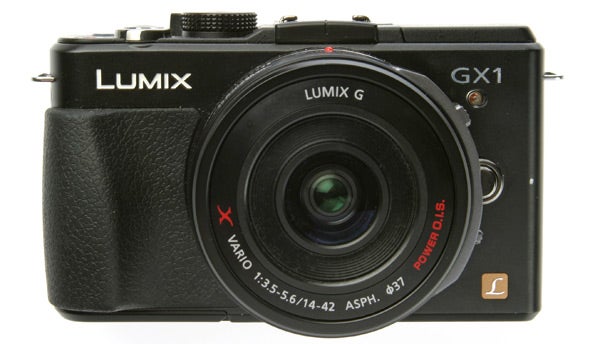
Verdict
Pros
- Small yet richly featured
- Excellent image quality
- Good low-light performance
- Built-in flash and hotshoe connector
Cons
- Lumix 'X' powered zoom can be a bit fiddly
Key Specifications
- Review Price: £750.00
- 16-megapixels
- ISO 160 - 12,800
- 1920 x 1080/50i movie recording
- Lightening-fast 24-point AF
- All-metal construction/rubberised handgrip
Thankfully, Panasonic did have something along those lines in the pipeline and so what we have here is a camera that takes the compact rangefinder design cues of the Lumix GF1 and GF2 and combines them with the enthusiast-centred feature set and customisation options of the Lumix G3. Of course, with the GF-series now clearly aimed at more casual photographers, a new series name was required; step forward the all-new GX range.
On paper at least, the GX1 looks to have just about everything covered. It’s small and portable, yet extremely well built; it offers plenty of physical controls, thereby enabling fuss-free, on-the-fly changes to regularly used settings; resolution is a very handy 16MP; it offers the same intuitive touch-screen control employed by other G-series models (including Touch Focus and Touch Shutter); and last but not least it’s a very adaptable and flexible camera that comes with an ever-expanding range of quality lenses and accessories.
That said, the days when Panasonic (and their Micro Four Thirds partners, Olympus) enjoyed almost free reign in the CSC market are long over and there are now plenty of excellent models from rival manufacturers, making this sector of the CSC market extremely competitive.
Has the GX1 got what it takes to see off the likes of the Sony NEX-5N, the Olympus E-P3, the Nikon V1 and the Samsung NX200? Let’s take a closer look and find out…
The GX1 is built around the same 16.1MP LiveMOS sensor that’s used to such good effect in the G3. As with the G3, the GX1 also benefits from the latest generation of Venus Engine image processor. In theory, this should mean that it is able to deliver the same high level of image quality we saw in the G3.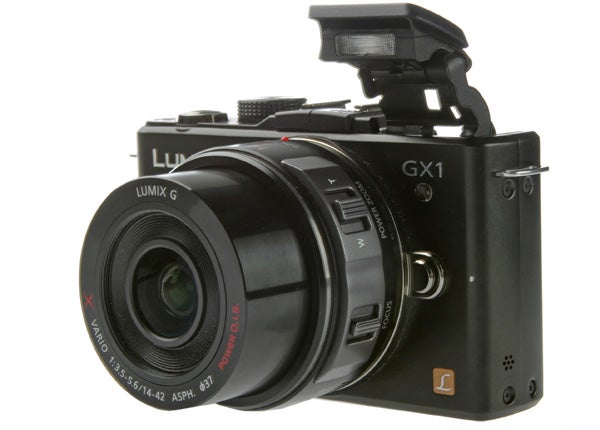
Sensitivity ranges from a baseline ISO 160 up to ISO 12,800 in standard mode, which is actually a stop above the maximum ISO 6400 offered by the G3. Able to shoot lossless Raw images (.RW2 format) or JPEG, or indeed both simultaneously, maximum output at full resolution in the native 4:3 aspect is 4592 x 3448 pixels, with reduced resolution settings of 8MP (Medium) and 4MP (Small) also available. There are two levels of JPEG quality: Fine and Standard. You can also choose to shoot in alternative aspects of 3:2, 16:9 and 1:1, which can help enormously with creative framing.
The GX1 hosts all the shooting modes you would expect to find on a Lumix G-series model, including the regular creative quartet of Program, Aperture-priority, Shutter-priority and fully Manual. These are backed up by Panasonic’s ever-reliable intelligent Auto Plus (iA) mode that can be accessed directly from a button on the top plate. When set to iA the camera goes into fully automatic mode, however simplified on-screen slider controls do allow novice photographers some degree of control to alter exposure, depth of field and colour temperature. Rounding things off are 17 individual scene modes and two user-defined Custom shooting modes.
In addition, the GX1 also gets eight Creative Control digital filter effects, including two new ones that didn’t make it onto the G3 in the shape of Toy Camera and Miniaturisation. All of the regular shooting modes, including iA, are supplemented by the regular array of Photo Styles that can be used to give your images a certain look and feel – from Standard to Natural, via Vivid, Monochrome, Scenery and Portrait. 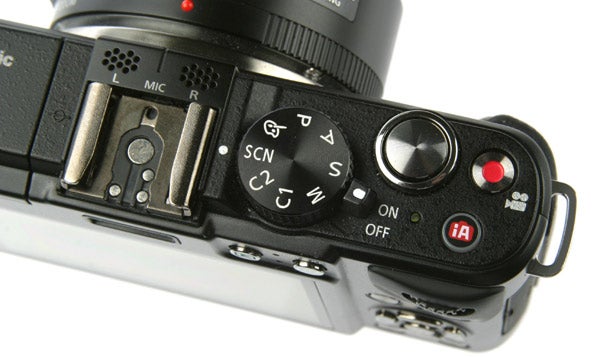
In addition to the two physical Function (Fn) buttons it’s possible to add two extra Fn shortcut icons to the touch-screen monitor. The range of functions that can be assigned to these shortcut buttons has been increased too. This should allow you to set the camera up exactly as you want it, with one-touch access to all of your most used features and functions – something that enthusiasts will doubtless appreciate.
New for the GX1 is an easy-to-use level gauge that, once switched on, looks a bit like the artificial horizon display inside an aircraft’s cockpit. Simply rotate and/or tilt the camera until the lines meet up and turn green and you’ve established a level horizon. It might sound like a minor feature, but if you regularly shoot landscapes then it could well prove invaluable.
Movie capabilities have received a boost over the G3 and GF3 too, with the GX1 offering a maximum recording quality of 1920 x 1080/50i Full HD with sound recorded in stereo via twin microphone inputs on the camera body. As with previous G-series cameras, movies can be stored in the space-efficient AVCHD format, although in a new move Panasonic has also included the option to save movies directly as MP4 files.
Our review sample came in Raven Black, however the GX1 is also available in a rather fetching Gunmetal Grey. Taking its design cues directly from the older GF1 and GF2 models, the GX1 is more angular than the rounded-off GF3. It’s quite a professional, workmanlike looking camera if truth be told, but we really like that aspect of it – far better to look like a serious tool than just another fancy gadget.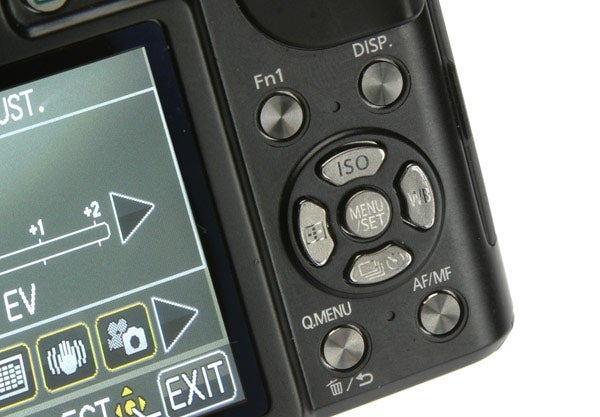
Overall build quality is very high too, with the GX1 benefitting from an all-aluminium outer casing. Unlike the G3, the GX1 also gets metal buttons and a rubberised (as opposed to moulded metal) handgrip. This is a particularly nice touch, quite literally, as it enables you to get a much more secure grip of the camera with. Physical buttons are well spaced and usefully assigned too, enabling you to jump straight to all of the shooting settings most regularly used such as ISO and AF mode. There are two physical Fn buttons located on the camera body (one of which can be used as an AF/AE Lock button), with a further two Fn buttons accessed via the touch-screen.
Should you want or need to enter the in-camera menus you basically have two options: the Q. Menu button opens up a paired-down menu of shooting settings, while the main Menu button located in the middle of the D-pad opens up the full in-camera menu. The main menu layout will look immediately familiar to anyone who’s used a Lumix camera before, with things neatly divided up between Stills, Movie, Custom, General, and Playback settings. It’s all fairly straightforward to get to grips with and the good news for advanced users is that the Custom settings menu is extremely thorough, with seven pages of sub-menu options that allow you to tinker with everything from Fn button assignment to display options.
In terms of overall size, the GX1 is comparable to both the Olympus E-PL3 and Nikon J1. The GX1 is just about small enough to fit inside a coat pocket, especially with a 14mm pancake lens or the 14-42mm ‘X’ powered zoom that our review sample came fitted with. However, should you want to keep a couple of alternative lenses to hand you’ll need to invest in a small carry bag. Even so, you’re still talking substantially less size and weight than you would for a DSLR and a comparable set of lenses.
As with the G3 and GF3, the GX1 gets a 3inch, 460k-dot, 3:2 LCD rear monitor that also offers some touch-screen functionality. It’s a bright, sharp and clear display, although we did find that it has a tendency to make captured images appear slightly darker than they really are when using the camera in Playback mode. This in turn can trick you into over-applying positive EV compensation and losing highlight detail. A better solution is simply to turn the screen brightness up via the menu settings.
The GX1 uses the same super-fast, 23-area, contrast-detect AF system employed by the G3. Working in tandem with the touch-screen the GX1 offers the same the same intuitive Touch AF and Touch Shutter features seen on other Lumix G-series models. For those unfamiliar with either, Touch AF basically allows you to select a point of focus simply by touching it on the LCD screen. Touch Shutter, meanwhile, takes the process one step further by recording an image the instant the focus is found, again simply by touching the point of focus on the screen.
With a claimed AF speed of just 0.09 seconds (marginally faster than the G3), Panasonic claims the GX1 is the fastest focusing compact system model on the market. It’s certainly true that the GX1 is every bit as quick as the G3, locking on instantly in good to moderate light. Even in darker conditions AF speed remains impressive with the GX1 able to find its target with little tendency to focus hunt. When conditions do become too dark a powerful AF Assist light on the front of the camera is able to illuminate subjects several metres away.
The GX1 benefits from both a built-in flash and a proprietary hot-shoe/accessory port that can accommodate a range of accessories including more powerful flash units and the LVF2 tilting electronic viewfinder (EVF). This slots onto the accessory port and offers the equivalent of 1.44million-dots. Better still, it can be tilted up to 90-degrees for extra flexibility. Whereas we’re happy to admit to having serious doubts over the performance of EVFs in the past, it would appear that the technology is getting to a stage where the latest generation of EVF units (the Lumix LVF2 included) are actually quite useable.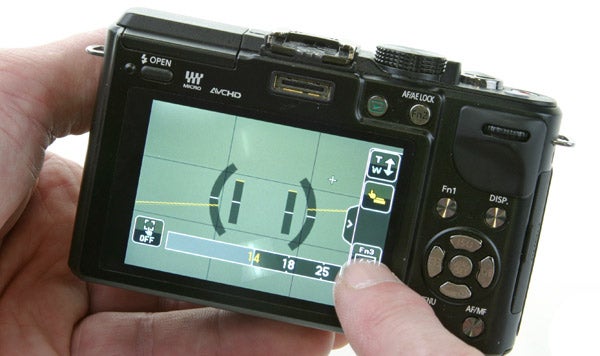
Start-up time clocks in at a fraction over two seconds, and while this isn’t quite up to the instant start-up time of most DSLRs it should be perfectly acceptable for the majority of situations. Continuous shooting speed maxes out at 4.2fps, which is marginally faster than the G3 (by 0.2fps no less!). As with the G3, this can be increased to 20fps at 4MP if your priority is all-out speed rather than quality.
The GX1 is offered with a choice of kit zoom lens packages: with the (cheaper) standard 14-42mm zoom, or with the powered ‘X’ 14-42mm zoom that our review sample came fitted with. While we like the way this closes down to something only a little bigger than the 14mm pancake lens it’s considerably slower to use than a manually operated lens, taking around two seconds to move between the extremes of its focal range. We also found the positioning of the zoom control on the lens barrel a little awkward to reach when holding the camera in standard landscape mode.
It’s worth noting that the Lumix ‘X’ powered zoom is a premium lens with a similarly premium price. However, if the £730 asking price for the package puts the GX1 out of your price range then the good news is that the GX1 is also available with a regular (manually operated) Lumix 14-42mm kit zoom for around £200 less. Yes, the standard lens is physically bigger, but you could always invest the savings in a prime lens, or perhaps even the LVF2 electronic viewfinder.
Overall image quality is fantastic and certainly on a par with the G3, with the GX1 being able to produce images full of bright, vibrant colours, pleasing tonality and contrast, sharp edges and good levels of detail. Given that the two cameras share the sensor and image processor this probably shouldn’t come as such a shock. 
As is common with many digital cameras these days, the GX1 allows you to choose from a set of predefined processing styles. In keeping with other recent Lumix G-series releases the GX1 offers a choice of: Standard, Vivid, Natural, Monochrome, Scenery, Portrait and Custom. We tended to favour the Standard setting as it offers a happy medium between the deliberately flat Natural setting and the highly saturated Vivid setting, and is the easiest to work with when shooting in Raw. That said, we also found ourselves switching over to Vivid on a number of occasions when the light was really flat and our subject required a bit of extra pop.
In addition to Picture Styles, the GX1 also features a good range of supplementary image-shaping technology, including Intelligent Resolution (which generates sharper edges and greater emphasis of fine detail) and Intelligent Dynamic (which creates the impression of an increased dynamic range for high-contrast scenes). On top of this the GX1 also offers Shading Compensation (which corrects vignetting by lightening the corners) and Long Shutter Noise Reduction (which lessens the effects of image noise). All of these certainly have their uses, and can be used quite effectively as a general safety net for overall image quality. That said, turning such functions up too high can also result in unnatural looking images, so some prudence is required.
Metering is taken care of via a 144-zone multi-pattern sensing system and proves consistently accurate, although we did notice an occasional tendency to slightly underexpose some images in tricky (high-contrast) lighting conditions. Of course, this is easily rectified via the ±5EV of exposure compensation that’s provided. We encountered no such problems with Automatic White Balance setting, with the GX1 producing accurate colour reproduction in a variety of natural and artificial lighting conditions without any overly warm or cold hues creeping in.
Low-light and high sensitivity shooting is another area in which the GX1 does very well – at least when the camera is taken out of studio test conditions and used in real-life situations. If truth be told though, our ISO test results weren’t quite as good as we’d expected them to be. Shooting on a professional-grade tripod and using a combination of Aperture-priority, self-timer, manual focus and consistent studio lighting, images taken at ISO 160 and ISO 200 were as noise free as we’d expected, however we did begin to notice some image softening creep in as low as ISO 400, becoming more noticeable at ISO 800 and ISO 1600 – especially when viewed at 100%. At ISO 3200 image quality begins to drop off quite noticeably, with the highest settings of ISO 6400 and 12,800 very much for emergencies only.
Verdict
The Panasonic Lumix GX1 is an excellent enthusiast-level compact system camera that offers plenty of flexibility and customisation options in a small and stylish package. On top of this, build quality is excellent and image quality rarely disappoints. Overall, it’s a camera we have no hesitation in heartily recommending. If the £750 asking price for the GX1 and Lumix ‘X’ 14-42mm powered zoom package reviewed here pushes the GX1 out of your price range then bear in mind that it can also be purchased with a standard 14-42mm kit zoom for around £200 less.

The baseline sensitivity setting of ISO 160 delivers sharp, noise-free images

Moving up to ISO 200 there is no visible difference in quiality to ISO 160

At ISO 400 there is the merest hint of softening, although this is only visible when images are viewed at 100% or more

At ISO 800 this softening becomes more pronounced, although again only when the image is viewed at 100% or more

ISO 1600 is a touch softer than ISO 800, although overall image quality still holds up very well

IS0 3200 is where noise begind to become an issue with noise visible even when the image is viewed at less than actual size

ISO 6400 isn’t the greatest, with very visible image degradation

The top setting of ISO 12,800 is really for emergencies only

Stepping outside the studio for a moment, it’s important not to lose sight of how well the GX1
performs in a real-life situations. The image above was shot at ISO 800
and has been resized to fit a 15inch desktop monitor (click on the image to enlarge it). Viewed at this size the image remains perfectly sharp with good levels of detail and accurate
colour reproduction. In fact, far from being problematic noise really isn’t an issue at all.

The image of the bi-plane above was shot at ISO 1600 and, again, noise is far from being a problem. Indeed, overall image quality is very good.

1/200sec @ f/8, ISO 200, 28mm, AWB

1/100sec @ f/3.6, ISO 400, 30mm, AWB

1/100sec @ f/4.7, ISO 400, 46mm, AWB

1/50sec @ f/5.6, ISO 800, 28mm, AWB

1/80sec @ f/6.3, ISO 800, 30mm, AWB

1/100sec @ f/4.4, ISO 400, 40mm, AWB

1/320sec @ f/5.6, ISO 1600, 84mm, AWB

1/125sec @ f7.1, ISO 200, 84mm, AWB
NB – The following images were all taken with a GX1 pre-production sample.

1/40sec @ f/5.6, 33mm, ISO 400, AWB, Vivid Photo Style

1/250sec @ f/2.5, ISO 800, 14mm, AWB

1/5sec @ f/8, ISO 160, 14mm, AWB, tripod

1/40sec @ f/5.6,ISO 400, 14mm, AWB

1/25sec @ f/5.6, ISO 800, 42mm, AWB

1/60sec @ f/2.5, ISO 1600, 14mm, AWB

1/250sec @ f/2.5, ISO 1600, 14mm, AWB

1/125sec @ f/2.5, ISO 1600, 14mm, AWB
Trusted Score
Score in detail
-
Value 8
-
Design & Features 9
-
Image Quality 9
-
Build Quality 10

